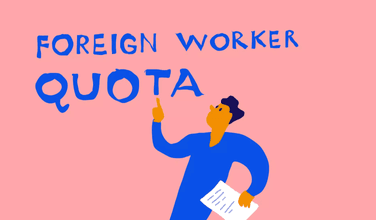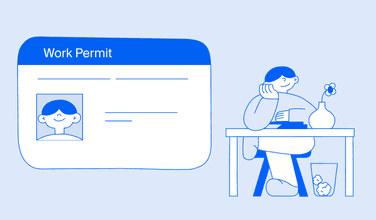- Osome Blog SG
- Foreign Worker Levy in Singapore
Understanding the Foreign Worker Levy: A Practical Guide for Employers
- Modified: 10 December 2025
- 9 min read
- Foreigner's Guide


Ruth Dsouza
Author
Ruth Dsouza Prabhu is a content developer with a passion for turning ideas into clear, engaging narratives. With a strong background in marketing communications and lifestyle writing, she simplifies complex business topics for entrepreneurs. Her work spans strategy, storytelling, and thought leadership, always focused on clarity, credibility, and impact.

Deepti Laddha
Reviewer
Deepti Laddha, our Head of Corporate Operations in Singapore, brings a decade of experience to her role, supporting our business writers in crafting insightful and engaging articles. With a strong background in corporate services, Deepti is a rich source of knowledge and expertise. We can count on her to assist in transforming any definition, concept or complicated jargon into helpful tips that help our readers take their businesses to the next level.
Hiring foreign workers in Singapore comes with specific responsibilities — one of the most important being the Foreign Worker Levy (FWL). This monthly payment helps regulate the number of foreign employees in the workforce while encouraging businesses to develop local talent. Understanding how the levy works, how it’s calculated, and when it’s due ensures your business stays compliant and avoids costly penalties.
Key Takeaways
- The Foreign Worker Levy regulates the number of foreign employees in Singapore, with rates based on skill level, sector, and quota.
- Timely monthly levy payments are essential to avoid penalties, permit revocations, or restrictions on hiring.
- Employers can reduce levy costs through higher-skilled worker applications or approved levy waivers for situations like overseas leave, hospitalisation, or repatriation.
What Is the Foreign Worker Levy
The Foreign Worker Levy (FWL), often simply called the levy, is a monthly fee employers must pay each month for every Work Permit holder they employ, forming part of Singapore’s levy framework to maintain a balanced labour market. It acts as a workforce control measure, helping balance the demand for foreign manpower with the economic growth of the local workforce and to promote local employment.
Your levy obligation begins from the date a Temporary Work Permit or Work Permit is issued, whichever comes first, and ends when the permit expires, is cancelled, or when you renew existing work permits under the stated levy requirements. The amount payable depends on factors such as your industry sector, worker skill level, and the foreign worker quota (set under the dependency ratio ceiling) your company is allowed to hire.
How the Foreign Worker Levy Is Calculated
How the Foreign Worker Levy's calculated varies depending on your company’s sector, the number of foreign employees hired, and their skill level. Levy rates are tiered, meaning that as you employ more Work Permit or S Pass holders, the levy rate per worker increases, with lower levy rates compared for higher-skilled workers versus lower skilled workers. This system helps balance the local and foreign workforce in each industry.
Understanding quotas and tiers
Every business sector in Singapore has a quota, which limits the proportion of Work Permit (WP) and S Pass holders you can hire compared to your total workforce to ensure compliance and support local talent as well as foreign talent. Within this quota, levy rates are divided into tiers — the higher your dependency ratio ceiling utilisation, the higher your levy rate, especially in the services sector.
S Pass levy rates
Sector | Quota | Levy Rate |
|---|---|---|
| Construction, Manufacturing, Marine Shipyard, Process | 15% | $ 650 |
| Services | 10% | $ 650 |
Work Permit levy rates
Sector | Quota | Tier | Percentage Range | Levy Rate (Higher-skilled / Basic-skilled) |
|---|---|---|---|---|
| Manufacturing | 60% | Tier 1 | ≤25% | $ 250/ $ 370 |
| Tier 2 | >25%–50% | $ 350/ $ 470 | ||
| Tier 3 | >50%–60% | $ 550/ $ 650 | ||
| Services | 35% | Tier 1 | ≤10% | $ 300/ $ 450 |
| Tier 2 | >10%–25% | $ 400/ $ 600 | ||
| Tier 3 | >25%–35% | $ 600/ $ 800 | ||
| Construction | 83.3% | Malaysians, NAS, PRC | ≤83.3% | $ 300/ $ 700 |
| NTS | ≤83.3% | $ 500/ $ 900 | ||
| Off-site | ≤83.3% | $ 250/ $ 370 | ||
| Process | 83.3% | Malaysians, NAS, PRC | ≤83.3% | $ 200/ $ 450 |
| NTS | ≤83.3% | $ 300/ $ 650 | ||
| Marine Shipyard | 77.8% | Basic Tier | ≤77.8% | $ 300/ $ 400 |
Factors affecting your levy bill
Several factors determine your final levy amount:
- Sector quota — The higher your proportion of foreign workers, the higher the levy tier.
- Worker skill level — More skilled foreign workers attract lower levy rates, which helps encourage employers to upskill staff and encourage hiring that supports employment for permanent residents.
- Nationality mix — In some sectors, rates differ for Non-Traditional Source (NTS) countries compared to Malaysia, NAS, or PRC.
You can calculate your company’s levy bill and quota entitlement using MOM’s official Guidelines for Employers of Work Permit (WP) and S Pass Holders (PDF), updated on 1 September 2025.
Levy Payment Schedule and Deadlines
Employers must pay Foreign Worker Levy fees for each month by the 17th of the following month, ideally using General Interbank Recurring Order (GIRO) as the primary payment method. If the 17th falls on a Saturday, Sunday, or public holiday, the due date moves to the next working day. The specific payment date for each month is stated in your levy bill.
For example, the levy bill for November 2025 will be due on 17 December 2025.
Payment options
- GIRO: Once your General Interbank Recurring Order (GIRO) arrangement is approved, the levy will be automatically deducted from your bank account on the 17th of the following month (or the next working day if it falls on a weekend/public holiday). Make sure sufficient funds are available in your bank account by 6 pm one working day before the deduction date to avoid failed transaction fees and financial penalties. Monthly deduction limits may also affect the payment.
- PayNow QR: If you do not have GIRO, you can pay your monthly levy via PayNow QR by the same due date.
Viewing your levy bills
Levy bills are made available online on the 3rd working day of every month, allowing employers to check the amounts before making payments and ensure compliance with MOM’s local regulations.
To avoid late payments and fees, consider applying for GIRO for automatic monthly deductions.
Penalties for Late or Non-Payment
Employers must pay the foreign worker levy on time to avoid serious consequences, as the levy applies to all workers subject to Work Permit or S Pass conditions set by the Singapore government. Missing payments can result in late payment penalties, revocation from work permit holders or S Pass holders after two consecutive missed months, suspension of applications to renew existing work permits, and even legal action to recover due levy. Companies headed by the same directors or partners may also be restricted from applying for new permits, and should consider conducting regular audits to avoid repeat breaches.
The penalty is calculated in two steps.
Step 1: Initial calculation
The formula used is:
2% × (1 ÷ A) × B × CWhere:
- A = Number of days in the month
- B = Amount of levy due
- C = Number of days the levy is overdue in that month
Step 2: Final penalty determination
- If the amount from Step 1 exceeds $20, that becomes the final penalty.
- If it is less than $ 20, the final penalty is the lesser of $ 20 or 30% of the unpaid levy.
Example
Suppose your levy of $300 for October 2025 is due on 19 November 2025, but payment is made on 5 December 2025. To calculate the initial amount, for November, you multiply 2% by the fraction of the month elapsed (1/29) and by the levy for the full month, giving $6. For December, you multiply 2% by 4/31 of the levy, resulting in $0.77. The total initial amount is therefore $6.77.
Next, to determine the penalty, compare the total initial amount with the standard rules. Since $6.77 is less than $20, the alternative penalty calculation would be 30% of the unpaid levy, which equals $90. The final penalty is the lesser of the two, so in this case, it is $20.
Applying for a Higher-Skilled Worker Levy
Upgrading a worker to higher-skilled status allows employers to benefit from lower levy rates and possible levy concessions in the construction sector and services sector. The exact levy reduction depends on the worker’s sector.
Eligibility and criteria
Foreign workers qualify for the higher-skilled levy based on sector-specific eligibility criteria:
- Construction and Process sectors: Workers must complete one of the approved upgrading pathways relevant to their sector.
- Manufacturing, Marine Shipyard, Services: Workers must have educational or worker's qualifications that meet sector standards.
Skills certification and supporting documents
To apply for higher-skilled levy status, you must submit the worker’s supporting documents.
Diploma or higher qualifications:
- China: Upload certificate of graduation and verification proof from CSSD (formerly CHSI) or approved background screening companies. Certificates notarised only are not accepted.
- Other countries/regions: Provide transcripts or letters from the educational institution confirming course duration.
Harbour craft industry:
Submit trade test certificates under relevant conventions:
- STCW Convention: Certificates of Competency (II/1, II/2, II/3, III/1, III/2, III/3, III/6, IV/2), ratings for deck or engine room watches, Able-Bodied Seaman certificates.
- Maritime Labour Convention (MLC): Cook Certificate of Proficiency.
Include verification from the issuing authority certifying the certificate is authentic.
Non-English documents require a professional English translation and proof of service.
For detailed instructions and forms to upgrade workers to higher-skilled levy:
Construction sector upgrading pathways
Levy Waiver and Rebate Options
Employers can apply for a levy waiver when their foreign workers are unable to work under specific conditions (e.g., overseas leave, hospitalisation, repatriation) by submitting a waiver period request in line with MOM’s procedures. A waiver reduces the levy payable for the affected period.
Eligibility requirements
Scenario | Waiver cap | Documents required |
|---|---|---|
| Attended Onboard programme | Automatic | None – processed automatically |
| Overseas leave (7+ consecutive days) | Up to 60 days per calendar year | None |
| Hospitalisation leave | Up to 60 days per calendar year | Medical certificate showing worker’s name, FIN, period, and clinic/hospital details |
| Custody by police or embassy | Case-by-case | Letter from relevant authority stating custody period |
| Worker passed away | Termless | Death certificate |
| On board vessel (harbour craft industry) | At least 3 consecutive days | Declaration from vessel captain (MPA form) |
| Malaysian worker on National Service | Usually 3 months | Letter from Malaysian authority and National Service completion certificate |
Application process
- Apply from the 1st of the month following the levy bill issue date, and state whether the worker held existing work permits or an employment pass during the claimed period.
- Submit within 1 year of the levy bill date.
- Processing takes up to 12 working days; longer if additional checks are needed.
- Once approved, the amount waived will be credited to your levy account to offset upcoming bills or can be refunded if no future payments are due.
- You can check application status or submit a new waiver through the Check and pay foreign worker levy service.
Calculating the waiver
Amount waived = Monthly levy rate − Levy payableExample
- Waiver period: 1–15 September
- Worker’s monthly levy: $ 600 ($ 19.73 daily)
- Levy payable for 15 days: 15 × $ 19.73= $ 295.95
- Amount waived: $ 600− $ 295.95= $ 304.05
How Osome Can Help
At Osome, we make staying compliant with Singapore’s employment regulations effortless. Our payroll service includes calculating and submitting all statutory contributions, including the Foreign Worker Levy (FWL), CPF, and SDL, so you never miss a deadline or overlook FWL obligations. We handle monthly filings, issue payslips, and prepare IR8A forms for your employees, ensuring accuracy and peace of mind. Whether you hire local workers or foreign workers, Osome’s experts and software work together to keep your payroll and levy obligations up to date — letting you focus on running your business. Don't hesitate to reach out!
Summary
The Foreign Worker Levy is a key part of Singapore’s manpower framework, designed to balance local and foreign employment and encourage employers to invest in local talent. Employers must pay the levy monthly for each Work Permit or S Pass holder, with rates depending on the worker’s skill level, sector (e.g., services sector), and company quota, which guides workforce management decisions. Timely payments are crucial to avoid penalties or employment pass/permit revocations. While the process may seem complex, understanding the levy structure, levy concessions, and how to apply for higher-skilled rates or waivers, helps manage labour costs effectively and maintain compliance with the Ministry of Manpower’s regulations.






